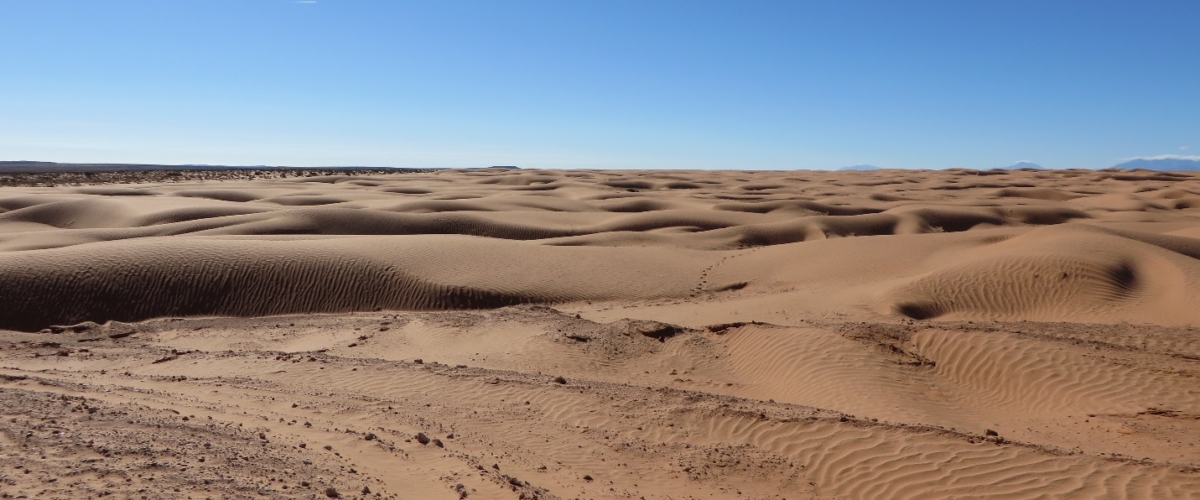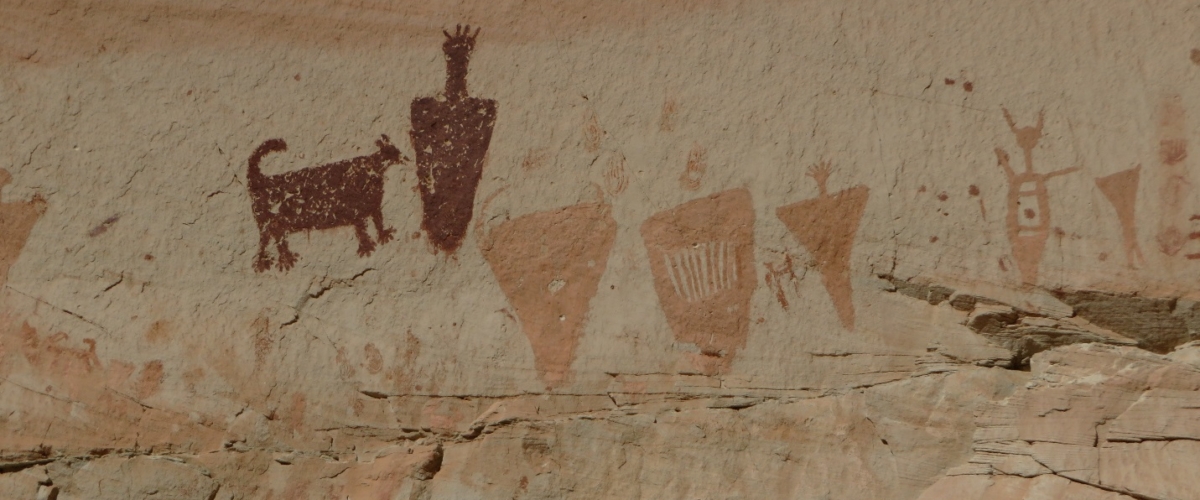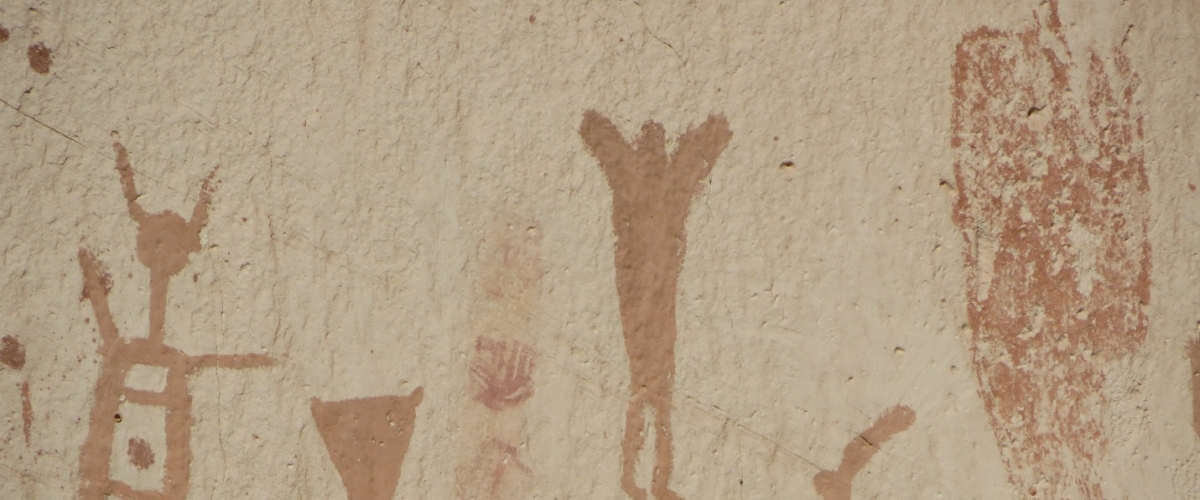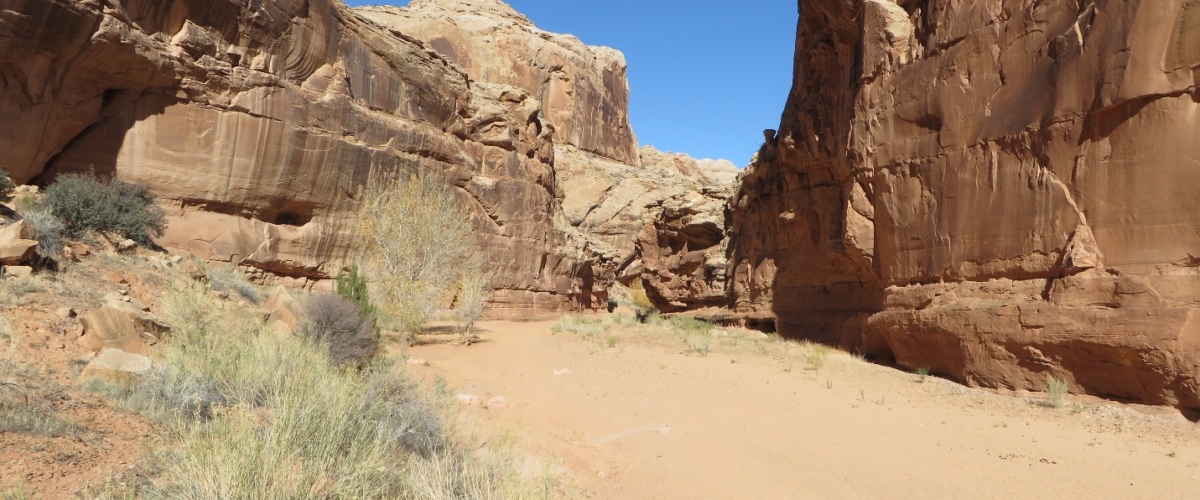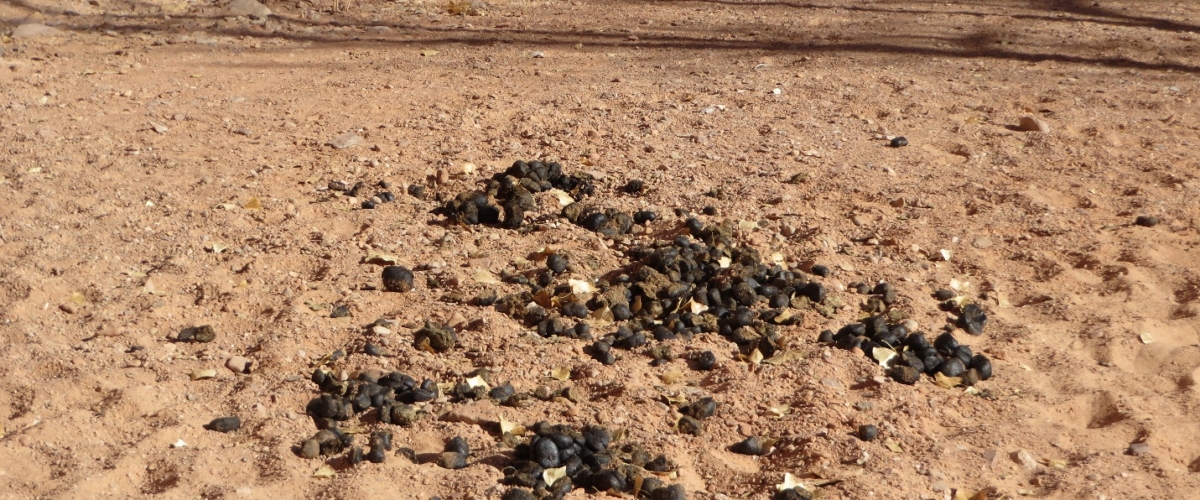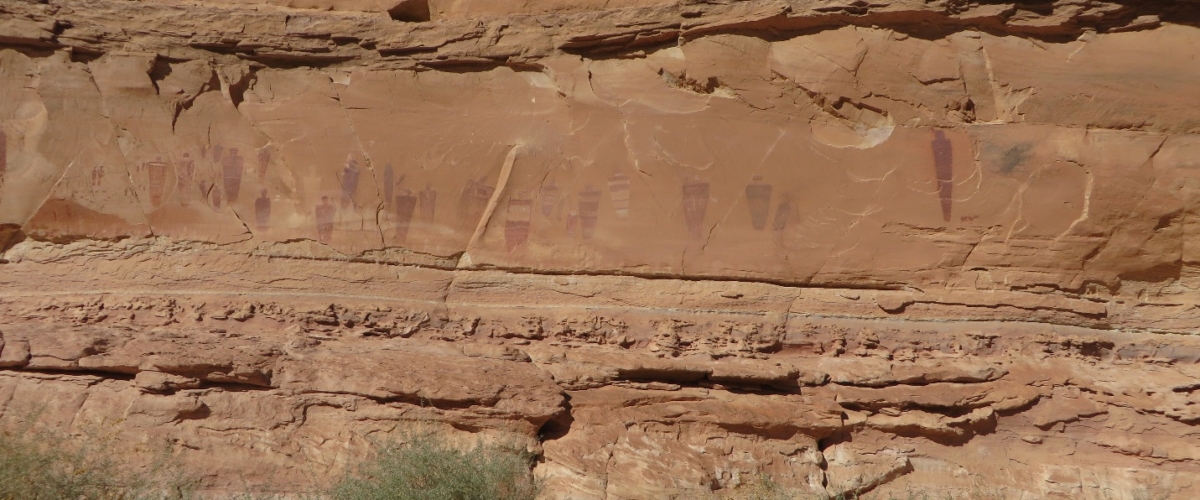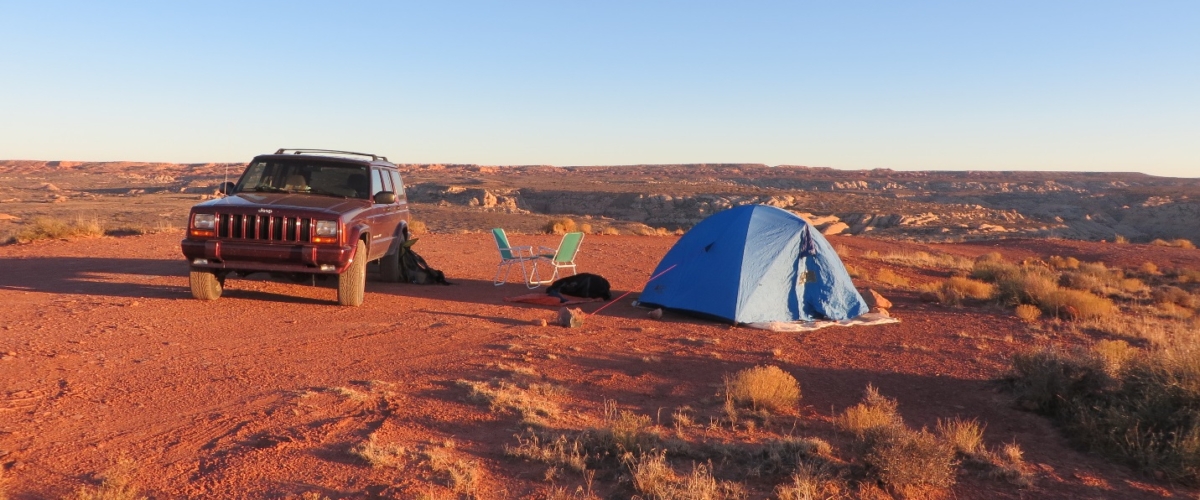Horseshoe Canyon Adventure
November 9th, 2017
We were on a car trip through Southern Utah, and enjoying the spectacular scenery. We were also enjoying the warmer weather, at least compared to our home in Calgary. November is not the greatest in terms of weather anywhere in Canada. Here in Utah it was unseasonably cool, but the weather was still excellent for hiking.
Our base was the campground in Goblin Valley State Park, and we had just completed some excellent hikes in that area, including the spectacular Little Wild Horse and Bell Canyon loop. Now it was time to move on, and leave the relative luxury of the state park with its hot showers for something more primitive.
We decided on Horseshoe Canyon, a very scenic hike not too far from Goblin Valley but very different. For one thing, Horseshoe Canyon boasts one of the most impressive displays of ancient rock art in the United States.
Horseshoe Canyon is part of Canyonlands National Park, but access is not simple. One has to leave the pavement of highway 24 and turn east onto an unpaved sandy road. We had a Jeep Cherokee, and so did not experience any problems on this 31 mile (50 kilometre) drive which eventually took us to a parking area on the rim of Horseshoe Canyon. The road led through desert, but in Utah every available acre however dry is used to graze livestock, and this area was no exception. From time to time, we saw isolated cows or small groups of cattle. Some vegetation grew in the desert and no doubt kept the cows alive, except for one place where there was an impressive area of sand with scenic dunes. Needless to say, the cattle seemed to shun this area. One can only hope that their presence will not hasten the conversion of the vegetated areas to similar sterile dune fields.
Our plan was to hike Horseshoe Canyon, and then car camp for the night on the rim. Although this was a very remote location, there was an amenity in the form of a lonely outhouse near the parking lot.
We parked the car, and left the trailhead. Initially, the trail led across a gentle rocky slope, and then it began to descend steeply into the canyon. Although the area was remote, ranchers and miners had been there before us, and had improved access into the canyon with the aid of dynamite. They had left behind evidence of their former presence, including water troughs, tanks, pipes, and as we shall see, burros. Currently, a fence and gate keeps cattle from surrounding ranches out of the canyon.
A wide ramp-like trail on bare rock let into the canyon, no doubt at least partly blasted by previous visitors who had profit rather than scenery on their minds. It certainly made our descent relatively easy. For a time, beehive-like rock formations occurred along the trail. These had multiple striations in different directions (cross-bedding) indicating that they had initially formed as ancient sand dunes.

The canyon was protected from grazing cattle by this gate.

Petrographs at Horseshoe shelter. Clearly some of them represent animals.
The canyon floor was relatively flat, which made for easy walking, although the sandy surface in many areas largely negated this advantage. A small stream, Barrier Creek, flowed through the canyon, and supported large cottonwood trees here and there.
There are several groups of petrographs along the canyon walls. The first one we found was on the right hand wall at Horseshoe Shelter, about 2 miles along the trail. These paintings are also often referred to as pictographs. Merriam Webster defines pictograph as “ancient or prehistoric drawing or painting on a rock wall” so that term would certainly apply to the paintings we saw here. Pictograph has many additional meanings, however, including “a pictorial symbol for a word or phrase”, and “a visual presentation of data using icons, pictures, symbols, etc.”
Petrograph has been defined as (Wiktionary) “drawing, writing or inscription on stone, as a painting on a cave wall.” According to Wikipedia, petroglyphs are images created by removing part of a rock surface by incising, picking, carving, or abrading, as a form of rock art”. They are distinct from petrographs which are drawn or painted on a rock face.
So I will use “Petrograph” in this account to make it clear that most or all of what we saw apparently involved paintings on the rock walls of Horseshoe Canyon.
After we had lunch there we pushed on from the Horseshoe Shelter area and on to the Grand Gallery. Along the way, the autumn foliage of the cottonwoods shimmered in the November sun against the sheer canyon walls. It was a beautiful hike.
Horseshoe Canyon is home to a group of burros who are not native to the area, and are no doubt wreaking significant environmental havoc. We did not see the burros themselves on this trip, although we did see scatological evidence of their presence as one of my photographs proves.
The burros of Horseshoe Canyon are apparently the descendants of animals left there by miners many years ago. Their species is of African origin, and there are those who feel they should be removed from the national park. In fact, one is able to sign petitions on the internet called “Remove destructive burros from Horseshoe Canyon.” It was interesting to see them there, but I have to agree that a strong argument could be made for their removal. Having said that, they are a historical remnant of past human activity. Ranchers began to use Horseshoe Canyon for their cattle herds over one hundred years ago, and the miners soon followed. Fortunately, no commercial mineral deposits were ever discovered in the canyon.
Eventually we reached the Grand Gallery; the most impressive rock art collection in the canyon. In fact, a whole type of ancient rock art has been named after the petrographs found here, the Barrier Canyon Style. Barrier Canyon was a previous name for Horseshoe Canyon. The Barrier Canyon Style includes anthropomorphic figures without arms and legs, of which there were many in the Grand Gallery.
One of the most striking collection of figures in the Grand Gallery has been called “The Holy Ghost and his attendants”, although this modern interpretation probably has little to do with the origins of these figures.
On the basis of rock slides in the area, one of which produced the cliff face on which the art is painted, and another that damaged some of the paintings, , the Grand Gallery rock art has been dated to between 400 to 1100 AD. As can be seen this date is quite imprecise. Of interest, an ancient leather bag containing chert flakes likely to be used for making arrow heads and some associated tools for making these was found in the sand near the Grand Gallery in 2005. This bag was carbon dated to approximately 850 AD. The bag also contained some marsh elder seeds which are edible. Whereas the modern hiker may carry granola bars or trail mix, the ancient inhabitants of this area seemed to travel with local edible seeds.
Archeology has shown that humans have lived in the Horseshoe Canyon area for much longer, likely for as long as 11,000 years. At that time, they probably hunted mammoths here for their food.

The Grand Gallery.

The sandy road back to the highway
There was a national park volunteer on duty at the Grand Gallery, and we were able to discuss the petrographs with him. It seems clear that no one alive has any idea of the significance of these paintings, and all we can do is speculate.
After viewing the Grand Gallery, we turned back towards the trailhead. One can go 0.3 Km further and look for three-toed dinosaur tracks, but we were unable to find them the year before, so we thought we would give them a miss this time.
There are other rock art sites in Horseshoe Canyon. These include the Alcove Gallery, which we did not see, and the High Gallery. On the way back, we watched carefully for a spur trail leading to the right, and eventually found it. A short walk along it led to the High Gallery. It had a smaller collection of art, and it was further away up the canyon wall, but was still interesting.
Eventually we began the climb out of the canyon. The elevation gain was manageable, only about 230 meters, and the total distance for our round trip to the Grand Gallery was also not great, only about 11 Km. Near the beginning of the ascent, stairs helped us to quickly climb through a sandy stretch. Then we had firm footing on the solid rock as the trail ramped rapidly upwards. Looking back, we could watch the shadows from the late afternoon sun march across the canyon floor, while the far wall glowed in the sunlight.
As we neared the canyon rim, we once again came upon the decaying structures left by the ranchers. There was a long water trough, an associated metal tank, and some pipes that must have been used to pump water from the canyon below.
We finally reached the canyon rim, and moved our car to a suitable flat area not far from the parking lot. We had the whole area to ourselves, and would have until the next day. As the sun slowly sank to the west, we busied ourselves with setting up our tent and making dinner. At some point in the evening, the park volunteer emerged from the canyon and left the parking lot for his house trailer several kilometers away. Then there was nobody, just the desert and us, and perhaps the spirits of those who had painted the rock art in the canyon below over a thousand years ago.
November 10th, 2017
In the morning we had breakfast in the solitude of the desert and broke camp. Then we were off down the sandy road to the highway. Horseshoe Canyon had once again been an amazing experience. Not only had we experienced its natural beauty, but we had also had the privilege of viewing its mysterious rock art one more time. The images on the canyon walls were like voices calling from the past and unifying us all into one broad all-inclusive humanity.



